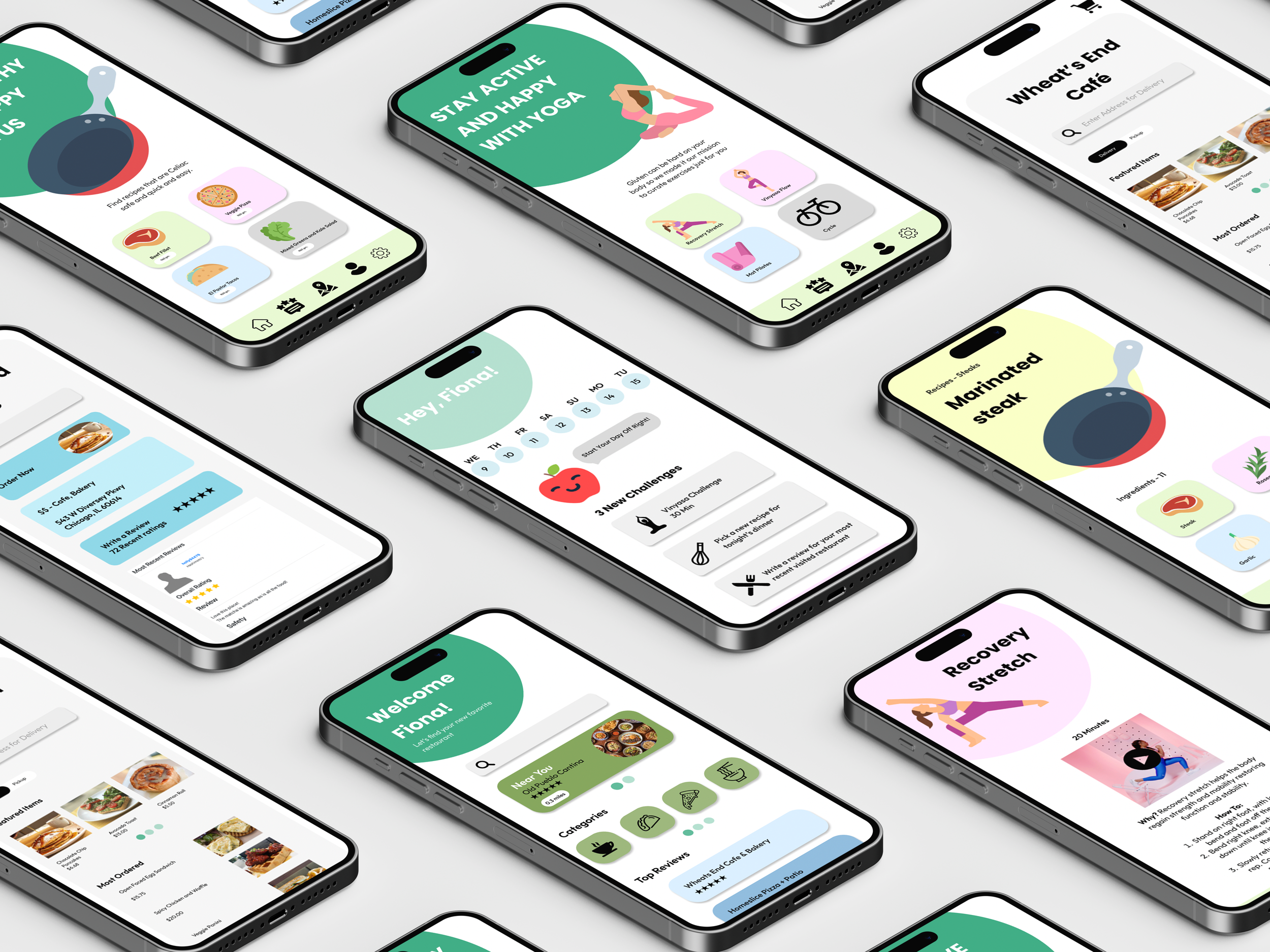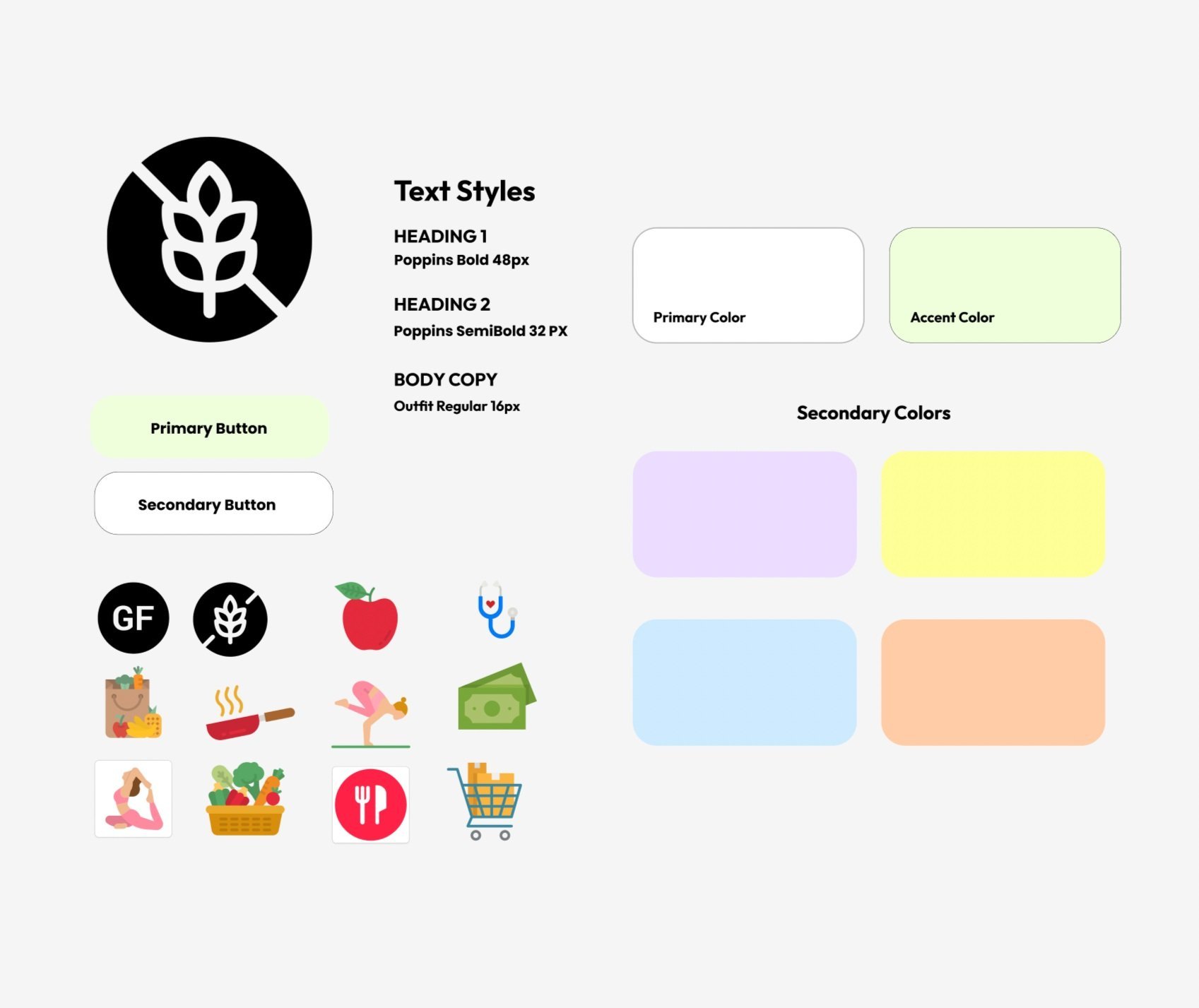
More is More
A unique interface experience to provide desired content to manage Celiac disease. The interface offers a comprehensive section of restaurants offering Gluten Free items for dine in and take out orders, at home recipes, and exercises for those who experience body pain. The app will also create a unique experience for users by filtering options based on their needs.
Case Study
-
Create a user-friendly app to help individuals with Celiac disease find gluten-free restaurants and products.
Offer personalized healthy habit suggestions, such as exercises for joint pain caused by gluten consumption.
Provide users with filtering options to customize their experience based on specific dietary needs.
-
Celiac disease is an ongoing issue for many individuals globally, with a high percentage going undiagnosed. Accessing gluten-free products without cross-contamination is a significant challenge. Many face both physical (e.g., joint pain, bloating) and psychological health impacts due to a strict gluten-free diet, further complicating the management of the condition.Unfortunately, the GF diet can be challenging and can lead to detrimental physical and psychological health outcomes. The most common symptoms of Celiac disease are stomach pain, bloating, weight loss, anemia, edema, or bone and joint erosion and pain.
Because Celiac disease can be asymptomatic, most go throughout life undiagnosed; for instance, About 83% of Americans go throughout their lives misdiagnosed with another condition or undiagnosed. In addition, diagnoses should be made early to avoid gastrointestinal symptoms, neurological symptoms, infertility, and/or tissue Transglutaminase (Springer Link). -
In the early stages of development, I focused on understanding both the user’s health challenges and business goals. Research involved competitor analysis of similar platforms to identify opportunities to offer more personalized and comprehensive features. This helped align the design process to provide a streamlined and beneficial user experience, tailored to the unique needs of individuals with Celiac disease.
-
In the competitive analysis, I assessed four prominent platforms catering to individuals with Celiac: Google, Yelp, Find Me Gluten Free, and the Fig app. Each platform offers unique features and functionalities to assist users in locating gluten-free options. Google and Yelp provide extensive restaurant listings but lack specialized features that filters could provide. Find Me Gluten Free focuses exclusively on gluten-free establishments, offering user reviews and ratings, while the Fig app integrates restaurant recommendations with personalized dietary restrictions and preferences. By examining the weakness of each platform I was able to identify opportunities to enhance user experiences.
-
After completing a thorough competitor analysis of Google, Yelp, Find Me Gluten Free, and the Fig app, I identified key pain points for users with Celiac disease. The goal was to design an app that addresses these gaps, offering more personalized, efficient ways to manage a gluten-free lifestyle.
Pain Points
Difficulty finding restaurants that are truly gluten-free and reliable in preventing cross-contamination.
Lack of personalized health and wellness resources (e.g., joint pain exercises) tailored to gluten-related issues.
Insufficient filtering options that would allow users to quickly find what matches their needs (e.g., product availability, restaurant menus).
-
User Goals
Easily find safe, gluten-free dining and product options with confidence in the absence of cross-contamination.
Access resources for managing physical symptoms (e.g., joint pain) and other health impacts of Celiac disease.
Filter recommendations based on personal preferences and dietary needs.
Persona
-
I developed user stories and a journey map based on two personas, Calum and Marie, who are newly gluten-free and in search of reliable restaurants and wellness information. These stories helped guide the user experience design to focus on simplicity and customization.
Key Questions Addressed
How can users quickly filter restaurant and product recommendations based on their needs?
What features can help users manage their gluten-free lifestyle holistically, beyond just food choices (e.g., health and wellness support)?
How can we ensure that the user feels confident in the information provided, particularly regarding gluten-free safety?
-
Using the personas and user stories, I created three key user flows to address common pain points:
Restaurant Discovery: Users can browse restaurants offering gluten-free options, with filters to prevent cross-contamination and display user reviews.
Product Recommendation Flow: A dedicated section allows users to search for gluten-free products, including details on safety and availability.
Health & Wellness Flow: The app offers personalized exercise routines for joint pain, based on user feedback regarding gluten consumption effects.
Wireframes
-
Layout:
The homepage offers a clean, minimalistic design with a prominent search bar at the top. Below, users can access quick links to key sections such as “Find Restaurants,” “Shop Gluten-Free Products,” and “Healthy Habits.”Main Features:
Search Bar: Allows users to search for restaurants and products by location, category, or specific needs (e.g., cross-contamination risk).
Quick Links: Simple, intuitive navigation directing users to relevant sections of the app based on their needs, like restaurant recommendations or wellness exercises.
-
Functionality:
A progress-tracking feature allows users to mark exercises as completed, which provides a sense of accomplishment and helps track improvement over time.
Mid Fidelity Prototype
-
The app’s visual design draws from soft, calming colors, meant to evoke a sense of trust and ease. The overall style is clean and minimal, helping users navigate the app without feeling overwhelmed. Elements from the style tiles and mood board were incorporated to give the app a welcoming yet professional tone, aligning with the needs of users who may already feel overwhelmed by managing their Celiac disease.
Solutions
-
Restaurant Recommendations with Filters
Users can access restaurant listings, each clearly marked with gluten-free safety information, including cross-contamination risks. Filters allow users to tailor their search by location, type of cuisine, and dietary needs.
-
Healthy Habits Section
A dedicated section offers exercises specifically aimed at individuals suffering from joint pain caused by gluten exposure, helping them manage their health in a more holistic way.
-
Customizable Experience
The app provides filters based on user preferences, allowing a more personalized experience for dining, shopping, and managing health-related aspects of Celiac disease.


